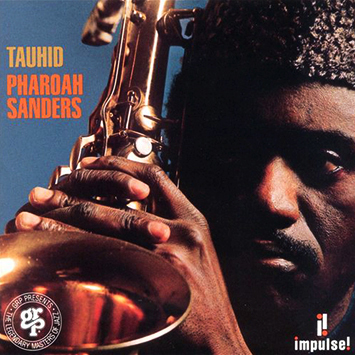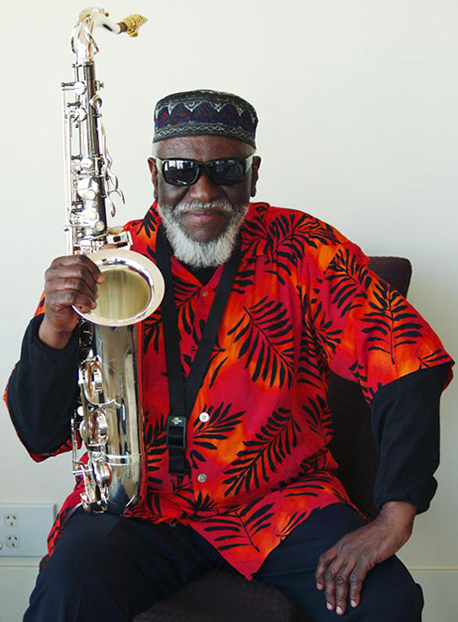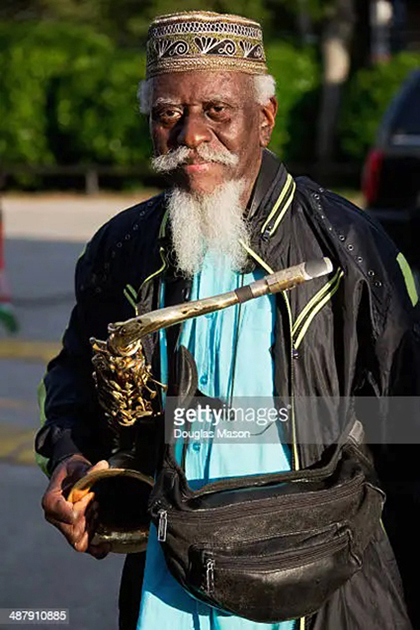Nigerian Juju Hilife
Pharoah Sanders (saxo tenor, cascabeles, voz), Joe Bonner (piano, voz), Peter Jujii (guitarra, voz), Jorge Pomar (contrabajo, voz), Babatunde Lea (batería, campanillas, shekere, voz) y big Black (congas). Extraído del álbum Rejoice (1981).
A finales de los años cincuenta Pharoah Sanders se escabullía en los clubs afroamericanos locales para tocar rhythm and blues y jazz con músicos que estaban de paso. Después de terminar sus estudios en la escuela secundaria se fue a vivir con unos familiares a Oakland (California), donde interpretó rhythm and blues, bebop y free jazz en clubs, actuando con el saxofonista alto Sonny Simmons, el saxofonista tenor Dewey Redman, el pianista Ed Kelly y los baterías Smiley Winter y Philly Joe Jones entre otros. En 1961 se trasladó a Nueva York, pero allí vivió como un mendigo hasta que el teclista Sun Ra lo incluyó en su banda. Además, tocó con el trompetista Don Cherry, uno de los padres del free jazz junto al saxofonista alto Ornette Coleman, y el batería Billy Higgins. En 1963 Sanders formó su primer grupo con John Hicks al piano, Wilbur Ware al contrabajo y Higgins, actuando en el club Village Gate, donde el saxofonista tenor y soprano John Coltrane lo descubrió.
In the late 1950s Pharoah Sanders slipped into local African-American clubs to play rhythm and blues and jazz with passing musicians. After graduating from high school he went to live with family members in Oakland (California), where he played rhythm and blues, bebop and free jazz in clubs, performing with alto saxophonist Sonny Simmons, tenor saxofonist Dewey Redman, pianist Ed Kelly and drummers Smiley Winter and Philly Joe Jones among others. In 1961 he moved to New York, but lived there as a beggar until keyboardist Sun Ra included him in his band. In addition, he played with trumpeter Don Cherry, one of the fathers of free jazz along with alto saxophonist Ornette Coleman, and drummer Billy Higgins. In 1963 Sanders formed his first group with John Hicks on piano, Wilbur Ware on double bass and Higgins, performing at the Village Gate club, where tenor and soprano saxofonist John Coltrane discovered him.

En 1964 Coltrane empezó a invitarlo a tocar en su banda cuando empezó a integrarse en el free jazz, aunque no pertenecía a ella de forma oficial. De este modo participó en la obra maestra Ascension (1965), así como en Live in Seattle (1965), Meditations (1965), Live at the Village Vanguard Again! (1966) y Om (1968), caracterizados por el total abandono de los conceptos tradicionales del jazz, como el swing y la estructura armónica, a cambio de una mezcla caótica de abundantes sonidos irregularmente distribuidos con largos solos disonantes. En 1964 Sander hizo su primera grabación Pharoah’s First con el sello ESP-Disc, pero los músicos que lo acompañaban tocaron bebop y no lo siguieron en sus aventuras libres, así que se quedó decepcionado. Por lo tanto, en 1996 cambió a Impulse! Records y publicó Tauhid, y los trabajos que realizó con este sello hasta 1974 fueron alabados por sus fans, la crítica y Ornette Coleman, John Coltrane y Albert Ayler.
In 1964 Coltrane began inviting him to play in his band when he started to integrate into free jazz, although he didn’t officially belonged to it. In this way he participated in the masterpiece Ascension (1965), as well as Live in Seattle (1965), Meditations (1965), Live at the Village Vanguard Again! (1966) and Om (1968), characterized by the total desertion of traditional jazz concepts, like swing and harmonic structure, in exchange of a chaotic mixture of abundant irregularly distributed sounds with long dissonant solos. In 1964 Sanders made his first recording Pharoah’s First with the ESP-Disc label, but the musicians accompanying him played bebop and didn’t follow him in his free adventures, so he was disappointed. Therefore, in 1996 he changed to Impulse! Records and published Tauhid, and the works he made with this label until 1974 were praised by his fans, critics and Ornette Coleman, John Coltrane and Albert Ayler.


En este caso, la introducción la comienzan Bonner y Pomar, y luego se incorpora la batería y la percusión con ritmos africanos. Entonces entra Sander para exponer el tema, que en realidad es una larga improvisación ligera y cordial transmitiendo buenas vibraciones, aunque incorporando de forma inevitable sus característicos sonidos desgarradores. Después le sigue Bonner con un discurso igualmente afectuoso que invita a pasárselo bien. A continuación vuelve Sander con sus overblowing combinados con melodías placenteras hasta que poco a poco la música se va desvaneciendo.
In this case, the introduction begins with Bonner and Pomar, and then drums and percussion join in with African rhythms. Then Sander enters to expose the theme, which is actually a long, light and warm improvisation transmitting good vibrations, although inevitably incorporating his characteristic piercing sounds. Later Bonner follows with an equally heartfelt speech that invites to have a good time. Afterwards, Sander returns with his overblowing combined with pleasant melodies until little by little the music fades away.

Translated with the help of DeepL

Origin
Pharoah Sanders (saxo tenor, cascabeles, voz), Danny Moore (trompeta), Steve Turre (trombón), Bobby Hutcherson (vibráfono), John Hicks (piano), Art Davis (contrabajo), Billy Higgins (batería) y Flame Braithwaite, Bobby London, Skinah Muhammad, Carroll Wilson Scott y Yvette S. Vanterpool (coros). Extraído del álbum Rejoice (1981).
Hicks hace una introducción enérgica basada en acordes y luego entra el coro mixto de cinco personas junto a Hutcherson, Davis y Higgins. A continuación Sanders expone el tema, y cuando el coro deja de cantar comienza su improvisación de forma entusiasta interpretando un jazz inspirado y dinámico. Al cabo de un rato el coro canta un riff procedente del tema mientras Sanders continúa su solo con autoridad y confianza. El riff se va repitiendo cada cierto tiempo complementando a Sander y al final el coro lo canta de forma continuada varias veces. Luego entra Hicks con un discurso original y vibrante dando rienda suelta a su imaginación hasta que el coro reexpone su papel en el tema y Sander termina poniendo el broche de oro.
Hicks makes an energetic introduction based on chords and then the five people mixed choir joins in with Hutcherson, Davis and Higgins. Next Sanders exposes the theme, and when the chorus stops singing he begins his improvisation enthusiastically interpreting an inspired and dynamic jazz. After a while the chorus sings a riff from the theme while Sanders continues his solo with authority and confidence. The riff is repeated every so often complementing Sander and at the end the chorus sings it continuously several times. After that Hicks comes in with an original and vibrant speech giving free rein to his imagination until the chorus re-exposes his role in the theme and Sander finishes putting the golden brooch.


